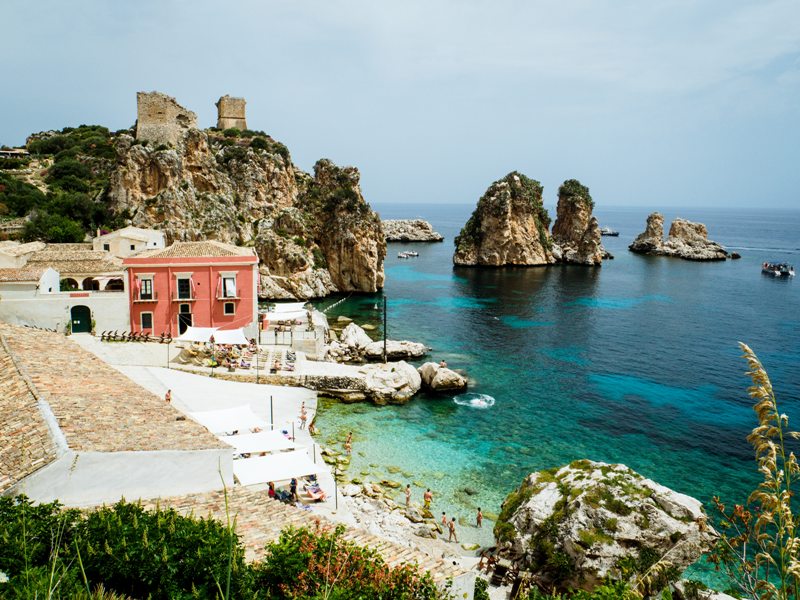You might consider Zeppole a simple dessert. A classic Italian pastry reminiscent of our American doughnut. Flour, eggs, butter, oil, and possibly a few other ingredients fried or baked with a dusting of powdered sugar.
However, under that golden brown delicious exterior lies a complicated and often contested origin story. Even trying to answer the question – what are zeppole – might illicit a response of… it is complicated or… it depends.
There are heated debates on the history of zeppole and the origin of its name. But, even the ingredients and the shape of zeppole can differ based on who and where they are made.
So, let us start with the basics. What are zeppoles?
What Are Zeppoles?
Good old Merriam-Webster provides a relatively short and sweet (pun intended) definition: a doughnut made from cream puff dough.
Wikipedia and its user-submitted content, goes much further with their description. It even includes size measurements. “An Italian pastry consisting of a deep-fried dough ball of varying size but typically about 4 inches (10 cm) in diameter. This fritter is usually topped with powdered sugar, and may be filled with custard, jelly, cannoli-style pastry cream, or a butter-and-honey mixture.”
Nikki Batsford, a food writer and blogger at Quahog.org, described zeppole as: “baked rings of pâte à choux filled with flavored pastry cream and garnished with powdered sugar and a maraschino cherry.”
While these definitions share some aspects, they also differ in others. Are they dough balls or rings? Dusted with powdered sugar or filled with pastry cream with a cherry on top?
That is one of the wonderful things about zeppoles. The simple fresh ingredients of zeppole can be transformed into an array of interpretations depending on the country and even the region in Italy.
One thing we can all agree on – zeppole are much loved by Italians, Italian-Americans, Americans, and people all over the globe.

Italian Variations of Zeppole
A little internet sleuthing resulted in several websites that provided these great variations of zeppole from different locations in Italy. Thanks to Arte Cibo and Gran Caffè Gambrinus for the zeppole examples.
- Salento: Region of Apulia in Southern Italy. Originally the zeppole were deep-fried in lard. They are now fried in olive oil.
- Apulia: Region of Puglia in the heel of Italy’s boot. They make a lighter, oven-baked version of a zeppole.
- Sicily: Largest Mediterranean island. Zeppole are dough balls made with rice flowers and deep-fried. They are then glazed with orange blossom honey or covered in powdered sugar.
- Calabria: Region in southwest Italy. Their zeppole are served as Christmas cakes. They are potato-based dough, filled with ricotta cheese, sugar, cinnamon, and lemon. A savory version with anchovy or a sweeter option with sultana, a white oval seedless grape, is served on New Year’s Eve and New Year’s Day.
- Naples: Regional capital of Campania. While zeppoles are often associated with St. Joseph’s Day celebrations, they are available year-round, especially in smaller sizes, in Naples.
- Itrana: Province of Latina in Central Italy. In Itrana, they cover zeppole with honey instead of sugar.
- Teramo: Region of Abruzzo. The zeppole in Teramo is more like a large cream puff. They are filled with white custard with a sour cherry added on top.
Zeppole – What is in a Name?
Here in the United States, we know the name zeppole. It instantly evokes memories of the shore, street fairs, carnivals, or family gatherings.
Italians are reminded of St. Joseph’s Day celebrations with friends and family. Zeppole are often served on March 19th in honor of the Feast of Saint Joseph, an official Catholic holiday since 1479.
While zeppole is the most well-known name for these sweet treats, there are several other ways to refer to the famous pastry. It all depends on where you are in the world.
Other names and/or variations for zeppole include:
- Joseph’s fritters
- Joseph’s Day cake
- Saint Joseph Cake
- Zeppole di San Giuseppe
- Bignè di San Giuseppe
- Fritelle di San Giuseppe
- Sfinci di San Giuseppe
- Sfinge or Sfinzi

Where Did the Name Zeppole Originate?
There might be several ways to refer to zeppole within Italy, but here in America, we all know it by the name zeppole. Which begs the question – how did the name zeppole come about? There are a couple of prevailing theories.
- Latin origin: Those with a Latin flare believe the term zeppole originated from the late Latin word, zippulae, which translates to a kind of sweet, or sweet treat.
- Egyptian origins: One of the leading theories is zeppole originated from the Arabic word, zalābiyya, which means fried soft dough. Clifford A. Wright, author and food historian once wrote: “The medieval Arab zalābiyya, a kind of deep-fried doughnut sprinkled with sugar, exists today, both with that name and many others, including sifanj. Sifanj, coming from the Arabic word for “sponge.” This sifanj exists in Sicily, too, where it is called sfinci (or sfìncia) the word also derived from the Arabic.”
- Wood wedge: Another popular theory links zeppole with Saint Joseph, the father of Jesus and a carpenter by trade. A wood wedge is used to adjust the height of the furniture. The Italian word for a wood wedge is zeppa. Zeppole, zeppa – pretty close.
- Snake: Early on in Neapolitan kitchens, zeppoles were formed into an ‘S’ shape reminiscent of a snake or a snake wrapped around itself. The theory goes that the name originated from the Latin word, sepula, which translates to a snake.
What Are Zeppoles And What Is Its History?
First, we explored the question – what is zeppole, we then delved into the origin of the zeppole name, and now it is time to dig even deeper into the history of zeppole.
If you thought it was complicated before, just wait…
As with the origin of the zeppole name, there is no single unifying theory on how zeppole originated. With that in mind, we cover below the top 3 prevailing theories vying for supremacy.
1. Ancient Rome
There are some historians who speak of the ancient origins of zeppole. For the full story, we must turn the clocks back to 500 B.C.
On March 17th, Roman citizens celebrated the Liberalia festival signifying the end of winter. This was a day to celebrate and honor the gods, Bacchus, and Silenus, who were known as the wine and wheat deities.
The Romans drank wine, of course, in honor of Bacchus. To celebrate their wheat god, Silenus, they ate large amounts of wheat fritters which were. These wheat pancakes, cooked in boiling hot lard, were decorated with sugar or cinnamon.
Many early pagan holidays were incorporated into the Catholic faith and associated with Saints. The feast day for St. Joseph, a day for eating zeppole, falls two days after the ancient Roman Liberalia festival on March 19th.
So, the theory goes – the wheat fritters of the Liberalia festival morphed into the zeppole of the Feast of St. Joseph or St. Joseph’s Day.
2. Feast of St. Joseph
Another popular series of stories connects the creation of zeppole to that of St. Joseph and his Catholic feast day held on March 19th each year.
One legend has St. Joseph fleeing to Egypt with Mary and Jesus. Upon his arrival, Joseph became a frittellaro – maker of fried pastry – to support his family. The story led some to believe that St. Joseph was the patron saint of pastry chefs or the patron saint of confectioners.
Neither belief appears to be accurate. According to Catholic Online, St. Joseph is the patron of fathers, and workers including carpenters, travelers, and immigrants.
Another story, popular in the south, recounts a severe drought in Sicily during the middle ages in the 10th century. In fear of famine, the Sicilians prayed to St. Joseph. The rain came and disaster was averted. In thanks, the villagers promised to memorialize the day with feasts in his honor.
This tradition continues today in Italy and in America. Italian-American families will serve soup, pasta with breadcrumbs, olives, and figs. And it will come as no surprise that the star of dessert is zeppole.
3. Convent of Santa Patrizia
The third prevailing theory credits the nuns of the convent of Santa Patrizia in Naples with the invention of the zeppole. A baked version of the modern zeppole was first made by the nuns in the 16th century.
The convent is associated with the church of San Gregorio Armeno (“St. Gregory the Armenian”), also known as St. Patrick‘s Church. The church is located on Via San Gregorio Armeno south of the Via dei Tribunali, one of the most important streets in Naples.

Popularity of Zeppole in Italy
While the jury is still out on the correct origin story for zeppole, most credit its modern popularity to Don Pasquale Pintauro.
The 19th Century Neapolitan baker Pintauro, known as the inventor of sfogliatella, discovered a recipe for zeppole and began selling them from a street cart in Naples on St. Joseph’s Day. Ever since that time, zeppole became synonymous with the saint’s feast day.
The first official recipe for zeppole was included in the Neapolitan cookbook, Cucina Teorico-Pratica (Theoretical-Practical Cuisine). Written by Ippolito Cavalcanti, Duke of Buonvicino, the famous treatise was published in 1837.
Time to Enjoy the Ancient Tradition of Zeppole
We covered a lot of history and talked about saints, droughts, famines, and convents.
Now it is time to bring on the feast with the star of the day – zeppole.
You no longer have to wait for St. Joseph’s Day, street fairs, or a trip to the Jersey shore to enjoy this traditional Italian dessert.
Boardwalk Zeppoles is bringing zeppole right to your doorstep. Our traditional Italian recipe was perfected to capture the full Zeppole experience.
With Boardwalk Zeppoles you can go from your freezer to the oven to your table in only 12 minutes.
You can serve your Boardwalk Zeppoles with powdered sugar or pair it with one of our delicious dessert dips featured on our blog.
Serve your zeppole at holiday gatherings, family celebrations, or on game day. Your friends and family will love them.
CLICK HERE and get your Boardwalk Zeppoles today!




